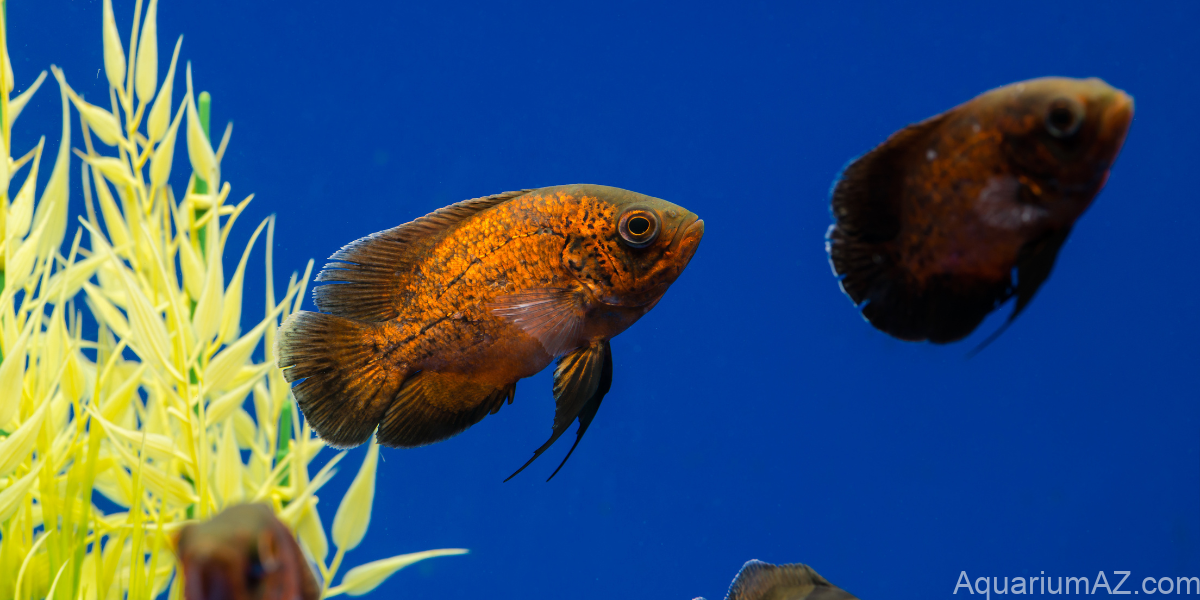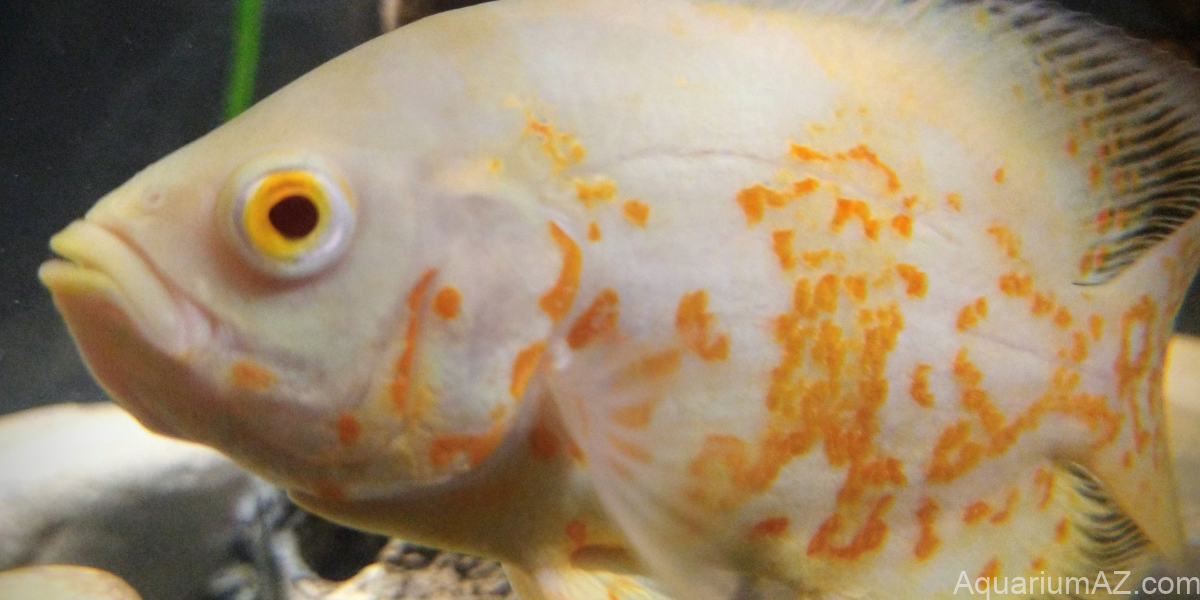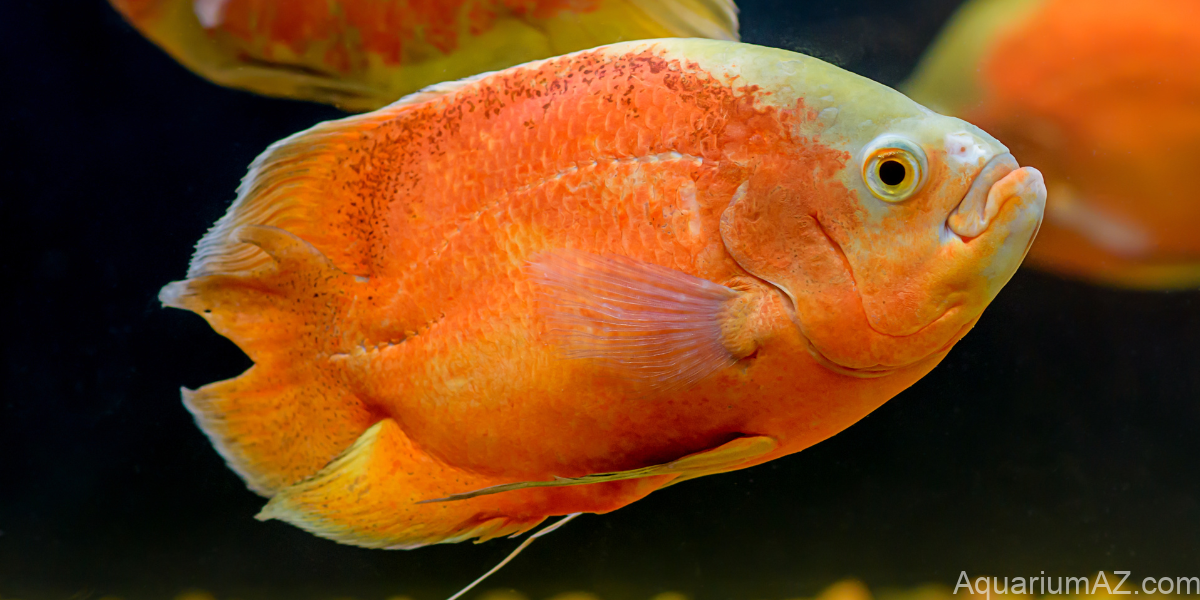Journey Through Oscar Fish Varieties
There are different types of Oscar fish (some people call them osker or oskar) people keep in aquariums. It is possible to train them to do tricks and recognize their owners. They are intelligent and can be trained to do tricks. They are available in various Oscar fish colors, with black and red being the most popular.
Oscars (misspelt as osker or oskar) do not interact well with other fish and should only be kept with larger fish in a spacious tank. They produce a lot of waste, which can affect water quality. Since they are messy eaters, they create a lot of waste. It is necessary to clean your pet’s tank regularly, change the water twice a week, and remove any debris.
Aquarium enthusiasts looking for an intelligent fish capable of learning tricks will find Oscars a great choice. Make sure you consider the tank’s size and maintenance requirements before buying one.
The Facts about Oscar Fish and Overview
- Family: Cichlidae
- Scientific Name: Scientific Name Astronotus Oscellatus
- Common names: Oscar fish, oscar cichlid, tiger oscar, velvet cichlid, marble cichlid
- Size: 10-18 inches
- Life expectancy: 10-20 years
- Care level: Intermediate to difficult
- Minimum tank size: 55 gallons
- Diet: Carnivorous
- Temperament: Could be aggressive
- Water temperature: 75-80°F
- Water pH: 6-8
- Water hardness: 5–20 dGH
Find out the most popular types of Oscar fish and their colors.
Tiger Oscars Fish
Tiger Oscar fish have black and orange coloration. However, it’s important to note that they don’t have black and orange stripes, but rather a black body with orange stripes and spots in various directions.

These fish have a unique appearance, resembling a combination of a labyrinth and a Rorschach test.
Their body is generally colorless, starting from the tip of their dorsal fin all the way through their upper lip.
Albino Oscar Fish
Albino Oscars are a popular breed of fish in aquariums due to their unique appearance, with a white primary body color and irregular red stripes composed of dots.

They tend to have more pronounced and irregular red stripes than Tiger albinos, making them a standout in any aquarium. Albino Oscars are highly sought after by fish enthusiasts and are sure to impress in any tank they are placed in.
White Oscar Fish
With its pristine, pearl-like colors, the White Oscar exemplifies elegance in its species Astronotus ocellatus.

With a length of up to 12 inches and ample hiding spots, it thrives in spacious aquariums with sand substrates. A variety of pellets, live, frozen, and occasional plant matter are all necessary for the White Oscar, despite its striking appearance.
When feeding time comes around, it frequently engages with its owners, showcasing its graceful movements while showing off its inquisitiveness and social nature.
It is important to manage the environments in captivity carefully when breeding White Oscars, so aquarists can observe their enchanting courtship rituals.
Red Oscar Fish
Due to its fiery hues, Astronotus ocellatus is one of the most prized variants. It can grow up to 14 inches in length and thrives in large aquariums with plenty of swimming space.

The Red Oscar maintains its vibrant coloration and robust health by eating pellets, live or frozen foods, and occasionally plant matter. While imposing in appearance, it has a curious and social nature, eagerly interacting with its owners when feeding time comes.
When breeding Red Oscars in captivity, aquarists are rewarded with the chance to observe this fascinating fish’s reproduction behavior.
Black Oscar Fish
Black Oscars are a striking freshwater fish, scientifically known as Astronotus ocellatus. Unlike other Oscar variants, it has a deep, velvety black coloration. As it grows up to 14 inches long, it needs a spacious aquarium with plenty of hiding spots.

During feeding times, Black Oscars often interact with their owners due to their curiosity and intelligence. The aggressive behavior of this fish can be mitigated with the help of appropriate tank mates and a well-decorated aquarium. Besides pellets, live or frozen foods, and occasional plant matter, it consumes an omnivorous diet.
There are specific environmental conditions and breeding tanks needed to breed Black Oscars in captivity. When properly cared for, the Black Oscar can live for over a decade, becoming a beloved aquarium resident.
Black and grey dominate their colors, giving them a distinctive appearance when compared with other varieties with more garish colors.
Lemon Oscar Fish
Lemon Oscars are a variety of Astronotus ocellatus with a bright yellow hue that adds warmth to any aquarium. With a length of up to 12 inches, it requires a large aquarium with plenty of hiding spots and a sandy substrate. As with other Oscar variants, the Lemon Oscar requires similar care, including pellets, frozen and live foods, as well as occasional plant matter.
As it interacts with its owners during feeding times, its sociable nature makes it very popular among aquarists. It is necessary to manage the environment and separate breeding tanks carefully when breeding Lemon Oscars in captivity. As long as the Lemon Oscar is properly cared for, it can flourish for many years, enchanting observers with its vibrant coloration and engaging personality.
How to Setup Tank for Oscar Fish and Requirements?
We will discuss these requirements.
- Size of the tank
- The substrate
- Filter for high-powered canisters or HOBs
- Lighting using LEDs
- The heater
- Plants that live (with caution).
- The use of decorations (with caution).
What Should Be the Size Of the Tank?
There is no stopping Oscars (osker or oskar) from growing, and they grow big. A 75-gallon aquarium (48 inches long, 18 inches wide, 21 inches high) would be ideal. One year after buying it, it can grow up to 10 inches.
For tank size, follow these guidelines
| Tank Size | Number Of Oscar |
|---|---|
| 75 Gallons | 1 Oscar |
| 125 Gallons | 2 Oscar |
| 150 – 200 Gallons | 3 Oscar |
It’s always better to go bigger. Larger bodies of water are better able to maintain a healthy environment since changes have less impact. You may need to exert maximum effort to meet these minimum sizes.
Filtration
Aside from being messy fish, Oscars (osker or oskar) also produce a lot of waste or bio load. Therefore, Oscars require a substantial amount of water filtration – primarily bio filtration.
The GPH rating of your filter should be 4x that of your tank size. In a 75-gallon, gives 300 GPH.
There is no need to worry about things if you have a powerful hang-on-back (HOB) filter or canister filter. Double-filtering is also popular among some people.
Based on our testing of a wide variety of canister filters and HOB filters, the Ultum Nature Systems DELTA and Seachem Tidal HOB filter are the top choices for an Oscar fish tank
The Substrate
There is no doubt that Oscars enjoy digging, as well as eating and spitting out substrate (such as sand). Some filters can be damaged as a result of this, particularly if your Oscar is projecting sand directly at the filters.
The use of sand as a substrate will not result in any damage if you incorporate a pre-filter into your tank. With this, you don’t need to buy a new filter every five seconds, so Oscar can dig up and spit out all the sand he wants
Heating
It is possible to avoid adding any additional heater to the tank if your tank is located in a room that maintains a stable temperature between 74°F – 81°F (23°C – 27°C).
Get a reliable, automatic-shutoff submersible heater if you don’t live in this climate all year. In the event of a sudden drop in water levels, the shut-off feature will prevent your Oscar from overheating.
Generally, 3-5 watts per gallon is a good guideline when choosing a heater. Therefore, a 225-375 watt heater is needed for a 75 gallon tank. As a result of testing multiple heaters, I recommend the Fluval e-series. During tests, it was found to be safe, accurate, and reliable.
Lighting
There is no need for specialist lighting for Oscar fish. You can keep them in a standard room lit by daylight.
However, adding some lights to your aquarium won’t harm your fish. Your fish might become agitated and distressed if you leave the bulb on for more than 12 hours. Oscars prefer moderate-low lighting.

ONF Flat ONE is one of strong candidate for your aquarium light system
Oscars may shy away from your bulb when it is on, so you might want to dim it (or remove it completely).
Have you ever wondered how to dim a bulb? Simple as that:
Wrap a piece of tin foil around the bulb and poke holes in it. There is a direct correlation between the number of holes and the brightness of your light.
Plants and Use of Decoration
Oscar fish should be kept sparse. If you pay attention, you will often see them moving small objects around their habitat as they rearrange their territories.
If you want to decorate with ceramic objects, you should be careful not to break them.
Rather than using real plants in the tank, use fake plants (if they are not completely destroyed).
Honestly, you should expect destruction; these little dudes are naughty!
Additionally, Oscar winners are clumsy; they move around a lot and clash with things constantly. As funny as that may sound, it has a serious point.
A Secret for Oscar Feeding : Balanced Diet for Health
When you select a tank for your Oscar Fish, you should also consider what type of food they need. Oscars can eat almost anything when they are feeding, but their diet typically includes live insects, larvae, and other fish.
You can occasionally feed them Goldfish or Rosy Red Minnows, but avoid feeding them too many feeder fish as they can become overweight.
To ensure your Oscars receive all the necessary nutrients, mix flake and pellet feeds equally with live foods such as shrimps and insects.
Oscars are known for their voracious appetites and will eat almost anything. However, to keep them healthy, it is essential to feed them a variety of foods. They require more Vitamin C and plants, which they would usually get from the animals they eat in the wild.
Adding algae to their diet is an excellent way to include fibrous plant matter in their diet without causing any digestive problems. When it comes to eating, Oscars are similar to their owners and love trying out different foods.
Oscar fish require a high-protein diet for optimal growth, especially during their juvenile stage. While they are omnivores, it’s recommended to supplement their diet with fresh and live fish food, along with high-protein flake and pellet fish food.
White worms are ideal for young Oscars, as they contain essential protein and fat for their development.
Feeding habits also play a role in their growth, so it’s best to feed juvenile Oscars 2-3 small meals per day, using a variety of different foods to keep their diet interesting.
Once they grow to 4-6 inches, feeding can be reduced to 1-2 meals per day, and as they reach 7-8 inches, they are considered adults. Monitoring their weight is important, and if they are gaining too much fat, it’s necessary to modify their feed type and/or frequency. Adult Oscars can be fed every day or every other day.
Oscar Fish Breeding: Is It Possible ?
Despite its viability, Oscar fish breeding is not the most straightforward endeavor. There is no doubt that Oscar Fish is one of the most difficult fish to breed.
There are many reasons why breeding Oscar fish is so difficult, including their notoriously difficult mating habits. They must be between 16 and 24 months old to begin spawning.
A mating couple that has produced offspring in the past or a group of youngsters that have grown up together can both be purchased.
The disadvantage of the second approach is that the fish may not be ready to mate for months, so it is best to stick with the first option of buying a married couple.
Various combinations of Oscar fish can be bred if they can “connect” and form a mutual admiration relationship.
Some of the most common fish breeders choose Tiger Oscars, Red Oscars, Albino Oscars, Yellow Oscars, and White Oscars.
If you are ever allowed to buy more exotic colors, like Pink or Purple, we suggest you refrain from buying them, or at least keep them in separate tanks.
Water Parameters: The Key to Oscar Fish Health and Happiness
| Attribute | Value |
|---|---|
| Temperature | 74°F – 81°F (23°C – 27°C) |
| pH level | 6.0 – 7.5 |
| Water Hardness | 5 – 20 dGH |
| Ammonia | 0 ppm |
| Nitrite | 0 ppm |
| Nitrate | <40 ppm |
Cycling your tank is necessary for achieving these safe water parameters. The purpose of this is to establish beneficial bacteria in the tank.
Maintenance Schedule For your tank: Daily and Weekly Tasks
- Maintain a steady water temperature between 74°F and 81°F (23°C and 27°C).
- Maintain equipment such as filters, heaters, and other components.
- Reduce nitrate levels and remove detritus by changing 40-50% of the tank water. Due to their large size and waste production, Oscars may require more frequent or larger water changes.
- Ensure pH, ammonia, nitrite, and nitrate levels are within appropriate ranges when testing water parameters.
- The Substrate should be vacuumed to prevent spikes in ammonia and nitrite levels.
- Make sure your fish is healthy: Look for signs of stress, illness, or aggression.
Some basic equipment is required
- A thermometer
- Scraper for algae
- Water Conditioner
- Vacuum for gravel
- A bucket that holds 5 gallons (for water changing)
Oscar’s Tank mates
Due to their assertive behavior and broad dietary preferences, Oscars thrive best in a tank solely dedicated to their species. While it’s possible to house other South American cichlids with Oscars, it’s crucial to ensure they are neither overly aggressive nor too passive.
Aggressive fish may harass passive ones, leading to potential bullying or even predation. In a community with Oscars, smaller fish become potential meals due to their size. Hence, it’s advisable to keep guppies and other small fish separate from larger Oscars to prevent any unfortunate mishaps.
Common Health Issues with Oscar Fish
Even though Oscar fish rarely get sick, they are at risk of catching several illnesses.
This disease is known as hole-in-the-head (HITH). Infected fish will have cavities and holes across their heads and bodies. That might sound freaky (and it is), but it can also be prevented:
In most cases, hole-in-the-head disease occurs due to nutritional deficiencies in the fish’s diet. Hole-in-the-head disease can be easily avoided if you follow the dietary guidelines we discussed above.
In addition to bacteria, viruses are also a major problem. The bacteria from settlements often found in live feeder fish (such as goldfish) can also make your fish sick. To avoid HITH disease, ensure your Oscar is fed a safe, high-quality diet, instead of feeder fish.
Conclusion : Would Oscar Fish be a good fit for you
Oscar fish is highly recommended if you can over-filter with regular water changes and have a 75, 125, or 150-gallon aquarium. There’s lots of personality in these lovable rogues.
If you intend to do an aquatic landscape with lots of plants and hardscapes, Oscar fish should not be purchased.
Oscars are a great choice for beginners and experienced aquarists as they are hardy and can endure bigger mistakes. As long as you keep up with water changes and provide them with enough tank space, they should be fine.
